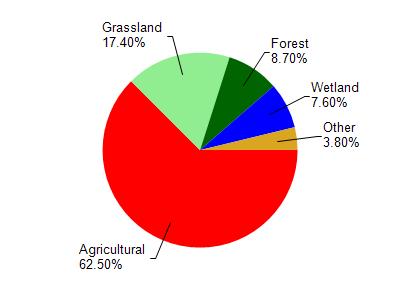Sheboygan
No
No
No
Fish and Aquatic Life
Overview
UNNAMED TRIBUTARY TO WALDO MILL POND (ONION RIVER) AT RM 32.3
T14N R21E Sec. 14 NWSE Stream Length = 2.7 miles WBIC = 52600
This is a small perennial stream that flows northeast from the Cascade Swamp, along the west side of Waldo into the Waldo impoundment. Channelization and lack of stream buffer in the upper reaches of this stream result in the stream being flashy. An undersized culvert in the lower reaches combined with flashy flows result in moderate to severe bank erosion and sedimentation. Tables 52 and 53 show the fish and habitat information collected during the 1994 basin monitoring.
Date 2001
Author Aquatic Biologist
General Condition
This waterbody was originally listed in 2002 due to degraded habitat. However, recent habitat evaluations, fish survey efforts and dissolved oxygen monitoring reveal that the entire length of the tributary. Instead, the section above Depot Street (STH 28) should remain listed while the downstream section should be de-listed based on the recent monitoring data. In addition, regional biologists have recommended that low dissolved oxygen be added as an impairment for the upstream segment.
(a) De-list tributary below Depot Street in Waldo (STH 28) for degraded habitat.
(b) Retain listing for degraded habitat above Depot Street in Waldo.
(c) Add low dissolved oxygen as an impairment for the segment above Depot Street in Waldo.
Date 2008
Author Robert Masnado
Condition
Wisconsin has over 84,000 miles of streams, 15,000 lakes and milllions of acres of wetlands. Assessing the condition of this vast amount of water is challenging. The state's water monitoring program uses a media-based, cross-program approach to analyze water condition. An updated monitoring strategy (2015-2020) is now available. Compliance with Clean Water Act fishable, swimmable standards are located in the Executive Summary of Water Condition in 2018. See also the 'monitoring and projects' tab.
Reports
Recommendations
Restore Wetlands
Restore Wetlands
Restore Wetlands
Restore Wetlands
Management Goals
Wisconsin's Water Quality Standards provide qualitative and quantitative goals for waters that are protective of Fishable, Swimmable conditions [Learn more]. Waters that do not meet water quality standards are considered impaired and restoration actions are planned and carried out until the water is once again fishable and swimmable
Management goals can include creation or implementation of a Total Maximum Daily Load analysis, a Nine Key Element Plan, or other restoration work, education and outreach and more. If specific recommendations exist for this water, they will be displayed below online.
Monitoring
Monitoring the condition of a river, stream, or lake includes gathering physical, chemical, biological, and habitat data. Comprehensive studies often gather all these parameters in great detail, while lighter assessment events will involve sampling physical, chemical and biological data such as macroinvertebrates. Aquatic macroinvertebrates and fish communities integrate watershed or catchment condition, providing great insight into overall ecosystem health. Chemical and habitat parameters tell researchers more about human induced problems including contaminated runoff, point source dischargers, or habitat issues that foster or limit the potential of aquatic communities to thrive in a given area. Wisconsin's Water Monitoring Strategy was recenty updated.
Grants and Management Projects
Monitoring Projects
| WBIC | Official Waterbody Name | Station ID | Station Name | Earliest Fieldwork Date | Latest Fieldwork Date | View Station | View Data |
|---|
| 52600 | Unnamed | 10022200 | Unnamed Tributary To Onion River | 11/1/2007 | 1/1/2015 | Map | Data |
|

Watershed Characteristics
Unnamed is located in the Onion River watershed which is 98.00 mi². Land use in the watershed is primarily agricultural (62.50%), grassland (17.40%) and a mix of forest (8.70%) and other uses (11.40%). This watershed has 132.85 stream miles, 143.10 lake acres and 5,098.92 wetland acres.
Nonpoint Source Characteristics
This watershed is ranked Not Available for runoff impacts on streams, Not Available for runoff impacts on lakes and High for runoff impacts on groundwater and therefore has an overall rank of High. This value can be used in ranking the watershed or individual waterbodies for grant funding under state and county programs.However, all waters are affected by diffuse pollutant sources regardless of initial water quality. Applications for specific runoff projects under state or county grant programs may be pursued. For more information, go to surface water program grants.